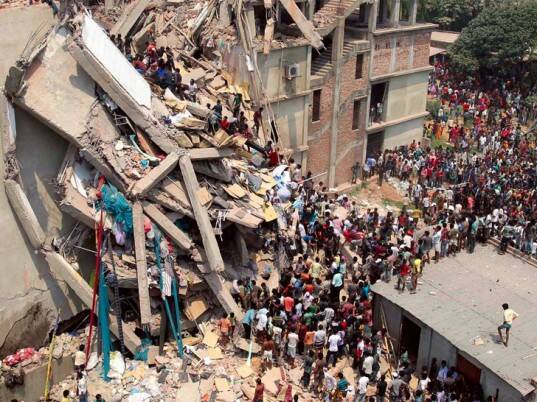Aklima and I are the same age: 20 years old. Yet our lives, lived on opposite sides of the world, have been drastically different. In August of 2008, when I was 14, I began attending a Jesuit high school in Western New York, with prospects of a good education and a bright future. When she was 14, Aklima started working 120+ hours a week in a garment factory in Dhaka, Bangladesh, often starting at 8 a.m. and working through midnight, suffering harsh labor conditions, abusive management and inadequate pay just so that she and her family could survive.
Just when it seemed that it could not get any worse, it did. On April 23, 2013, Aklima was working in Rana Plaza Factory when rumors began to spread of structural failure and worsening conditions. The workers were sent home halfway through the day, only to return the next morning to find the factory in no better condition. According to Aklima, the workers refused to enter the factory until the management began verbally and physically abusing them in order force their entrance. Aklima recalled that they were ordered to make 24,000 pieces that day, and all who refused would be fired and, if the quota was not met, no wages would be paid. Shortly after the workers returned to the factory, the electricity failed. “That’s when they started the generators,” said Aklima, “and the building began to collapse on top of us.” The collapse was so immediate that few could escape. Aklima stated that, in the shifting of the building as it collapsed, that she “was crushed under the machines she was working near,” and watched coworkers near her “crushed to death by falling machines and parts of the building.” In all, 1,129 workers were killed and over 2,500 had to be rescued. Aklima was under the rubble for over twelve hours before rescuers found her.
One of the most disturbing parts of this story is that brands that many of us wear were produced at Rana Plaza. Over 1,100 people died because Western brands and businesses were more concerned with cheap labor rather than the conditions in which those goods were produced. And yet, after all of this, there is clear and disturbing division amongst Western brands on how to approach this matter. One group, according to the New York Times, has over 150 members in support of the Bangladesh Accord for Fire and Building Safety, including 14 American companies. The other group, The Alliance for Bangladesh Worker Safety, counts amongst its members 26 companies, all American or Canadian.
So which is better?
Aleya Akter, a labor organizer who worked in the Bangladeshi garment industry from the age of 10, supports the Bangladesh Accord for Fire and Building Safety. “Conditions are worse than ever,” she said. “Unions are now getting directly involved with the inspection process under Accord. People who know what’s wrong in the factories are now able to point those problems out.” Aleya claims that the Alliance, unlike the Accord, promises no real change and that it is “useless.”
Proponents of the Alliance claim to have inspected over 400 factories already in their effort to increase safety, whereas the Accord has inspected only 300. Collectively, the two groups have inspected only 20 percent of the nearly 5,000 garment factories in Bangladesh. Proponents of the Accord claim that the Alliances inspections, though greater in number, are not as thorough or as effective in implementing changes. Some state that the effort alone is a great change in Bangladeshi labor rights and conditions. Dara O’Rourke, of UC Berkeley, told the Times: “They’re trying to bring up the worst garment conditions in the world. What they’re doing is really, really hard.”
Many continue to recognize the ineffectiveness of the Alliance and the necessity for further action, especially among college consumers. University students, at Duke, Cornell, NYU, Columbia, and Georgetown among others, have led the charge to pressure apparel-providing companies to engage in fair-labor practices in countries such as Bangladesh. It makes sense to place universities at the forefront of this battle: they are not only huge consumers of these goods, but they are also forming the next generation of consumers. Only through education and the encouragement of the actions of students in the pursuit of justice can we begin to create the society we seek that cares for the poor, the sick, the abused and the downtrodden. Universities often force their students and faculty to be passively involved in unfair labor practices by not interrogating the sources from which their goods are produced. As Aklima said at Fordham, “Do the universities want us to die in making their clothing, or will they stand with the workers in their fight for justice?”
The fight for international human rights, for fair labor practices, for recognition of injustices and for safe labor conditions is one that must continue. A significant portion of the world’s population is suffering due to unjust labor practices and consumerist greed. We must work to make sure that labor practices are respected, not only in Bangladesh but throughout the world, so that tragedies like Rana Plaza cannot happen again. No one should be placed in harm’s way so that we can be a little more comfortable and save a little money. A little bit of compassion and care, coupled with the practical implementation of labor laws, can get us farther than we ever thought in the fight against the violation of the dignity of the human person and their right to life outside of desperate poverty.
Nicholas D. Sawicki is an intern at America.








